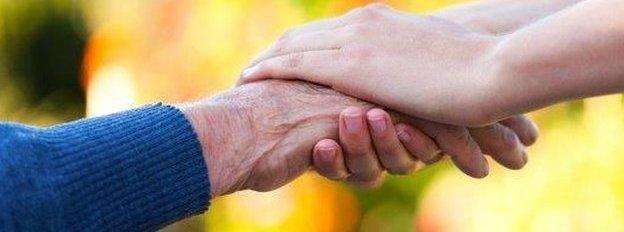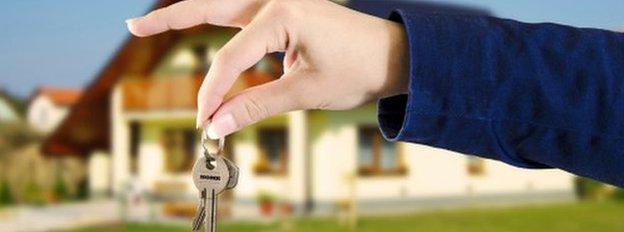Keeping people out of care homes
- Published
Health correspondent Nick Triggle sees how a new system in Leeds helps keep people out of care homes
The push in recent years has been to keep people out of care homes by providing support for them in their own home. Leeds has been at the forefront of this. So what has the city been doing?
It is an unlikely setting for a revolution in care, but the former disused warehouse on the New Dock industrial estate close to the centre of Leeds is being seen as the future of support for the elderly.
Over the course of this year, the warehouse has undergone a £2.1m refurbishment to make it into Leeds City Council's assisted-living hub.
It acts as a one-stop shop for care needs. Blue badge applications, which allow people with mobility problems to access extra parking spaces, are made there, and it houses all the home-adaptation equipment, such as stair-lifts and grab rails.
When it is fully functioning, in the next couple of weeks, it will also be home to the tele-care response team, which monitors the alerts from the 16,000 homes connected up to the system.

Home care in numbers

Over 4m people over the age of 65 - about one in two - have some kind of care need
About 2m of them have difficulty with one or more daily tasks, such as washing, dressing, cooking or eating
There were 370,000 getting council-funded home care in 2013-14
Once those who pay for care themselves are taken into account, the numbers hit 850,000
Another 1.5 million rely on family and friends to provide support

Tele-care covers a variety of different devices from bed sensors and flood alerts to devices that raise the alarm when a person has fallen. There are even GPS tracker systems that will activate when a person moves outside their designated "safe zone".
"This is the third generation tele-care," says Adam Ogilvie, the council's executive member for adult social care.
"Originally we had the pendants that hang round people's necks, then the second generation was all the sensors we put around the home. This is a step on from that. Its particularly useful for people with dementia."
Residential care falling
By using tele-care, Leeds has been able to reduce the number of times carers need to go into people's homes as well as admissions to care homes and hospital because of crises.
Research by the council suggests over £2,300 a year is saved per tele-care installation.
This means the money they have for carers goes further and has contributed to the reduction in people needing care homes. The number of weeks of residential or nursing home care funded by Leeds has fallen by nearly a 10th in the past three years from 143,612 weeks in 2010-11 to 131,149 in 2013-14.

How Leeds are investing in the third way

It is not just technology that Leeds is investing in. Extra care housing is becoming increasingly popular too.
This is housing that is designed for people with care needs. They can be easily adapted and are centred around communal services, including on-site care. There are about 200 units in the city, but in the coming years that will be increased to over 800.
It mirrors the retirement village concept that has become popular in places such as the US, South Africa, Australia and New Zealand.
People are able to buy or rent properties in these self-contained communities and increase the level of care as they age, which prevents them needing the round-the-clock support provided by care homes.
Currently there are about 50,000 such retirement homes in the UK, providing accommodation to about 0.5% of the over-65 population. That compares with nearer to 5% in the other countries.
The complexes vary in type - from a new complex being developed in Battersea Park where homes are fetching up to £3m each to cities such as Birmingham and Leeds where many of the residents are tenants.

Bill Haggas, 75, is the perfect example of that. He was given a wrist-worn falls detector three years ago after he collapsed in his bathroom.
A smoke alarm, which is connected to the response team, has also been fitted in his home. If either goes off, a call is put through to the response centre.
Coupled with home adaptations, which were provided by the council when his late wife, Janet, was ill with multiple sclerosis, it means Bill can get by without carers calling in.
"I don't need them. But it is a reassurance to know that if I ever have a problem I can be connected through to people who will help me," he says.
Leeds tele-care team manager Donna Whitelock says: "Someone like Bill might have had someone calling in on him twice a day.
"Not because he needs care, but just to check in on him. That doesn't need to happen because of the tele-care. I think that is better for the individual and saves the council money.
"That is essential if we are going to be able to cope with the ageing population."